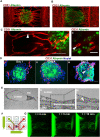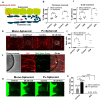In vitro grafting of hepatic spheroids and organoids on a microfluidic vascular bed
- PMID: 35704148
- PMCID: PMC9519670
- DOI: 10.1007/s10456-022-09842-9
In vitro grafting of hepatic spheroids and organoids on a microfluidic vascular bed
Abstract
With recent progress in modeling liver organogenesis and regeneration, the lack of vasculature is becoming the bottleneck in progressing our ability to model human hepatic tissues in vitro. Here, we introduce a platform for routine grafting of liver and other tissues on an in vitro grown microvascular bed. The platform consists of 64 microfluidic chips patterned underneath a 384-well microtiter plate. Each chip allows the formation of a microvascular bed between two main lateral vessels by inducing angiogenesis. Chips consist of an open-top microfluidic chamber, which enables addition of a target tissue by manual or robotic pipetting. Upon grafting a liver microtissue, the microvascular bed undergoes anastomosis, resulting in a stable, perfusable vascular network. Interactions with vasculature were found in spheroids and organoids upon 7 days of co-culture with space of Disse-like architecture in between hepatocytes and endothelium. Veno-occlusive disease was induced by azathioprine exposure, leading to impeded perfusion of the vascularized spheroid. The platform holds the potential to replace animals with an in vitro alternative for routine grafting of spheroids, organoids, or (patient-derived) explants.
Keywords: In vitro grafting; Liver organoids and spheroids; Microfluidics; Vascularization.
© 2022. The Author(s).
Conflict of interest statement
Paul Vulto, Dorota Kurek, Flavio Bonanini, Sara Previdi, Sander de Ruiter, Bart Kramer, Rumaisha Annida, Silvia Bonilla García, Karla Queiroz, Marine Meyer, Maria Clapés Cabrer, Roelof Dinkelberg, Thomas Olivier, Arnaud Nicolas, Karel Domansky, Erik Walinga, Jos Joore, Henriette L. Lanz, Sebastiaan J. Trietsch, and Bob Ronden are employees of Mimetas BV, which is marketing the OrganoPlate Graft and Paul Vulto, Jos Joore, and Sebastiaan J. Trietsch are shareholders of Mimetas BV. OrganoPlate is a registered trademark of Mimetas BV. Hans Clevers is inventor on several patents related to organoid technology; his full disclosure is given at
Figures




Similar articles
-
A multi-organ-chip co-culture of liver and testis equivalents: a first step toward a systemic male reprotoxicity model.Hum Reprod. 2020 May 1;35(5):1029-1044. doi: 10.1093/humrep/deaa057. Hum Reprod. 2020. PMID: 32390056
-
A microfluidic platform integrating functional vascularized organoids-on-chip.Nat Commun. 2024 Feb 16;15(1):1452. doi: 10.1038/s41467-024-45710-4. Nat Commun. 2024. PMID: 38365780 Free PMC article.
-
IFlowPlate-A Customized 384-Well Plate for the Culture of Perfusable Vascularized Colon Organoids.Adv Mater. 2020 Nov;32(46):e2002974. doi: 10.1002/adma.202002974. Epub 2020 Oct 1. Adv Mater. 2020. PMID: 33000879
-
In Vitro Generation of Luminal Vasculature in Liver Organoids: From Basic Vascular Biology to Vascularized Hepatic Organoids.Int J Stem Cells. 2023 Feb 28;16(1):1-15. doi: 10.15283/ijsc22154. Epub 2022 Oct 31. Int J Stem Cells. 2023. PMID: 36310029 Free PMC article. Review.
-
Recent methods of droplet microfluidics and their applications in spheroids and organoids.Lab Chip. 2023 Mar 1;23(5):1080-1096. doi: 10.1039/d2lc00493c. Lab Chip. 2023. PMID: 36628972 Review.
Cited by
-
Fluid flow to mimic organ function in 3D in vitro models.APL Bioeng. 2023 Aug 4;7(3):031501. doi: 10.1063/5.0146000. eCollection 2023 Sep. APL Bioeng. 2023. PMID: 37547671 Free PMC article. Review.
-
Vascular units as advanced living materials for bottom-up engineering of perfusable 3D microvascular networks.Bioact Mater. 2024 May 15;38:499-511. doi: 10.1016/j.bioactmat.2024.05.021. eCollection 2024 Aug. Bioact Mater. 2024. PMID: 38798890 Free PMC article.
-
High-throughput Bronchus-on-a-Chip system for modeling the human bronchus.Sci Rep. 2024 Nov 1;14(1):26248. doi: 10.1038/s41598-024-77665-3. Sci Rep. 2024. PMID: 39482373 Free PMC article.
-
Liver-on-chips for drug discovery and development.Mater Today Bio. 2024 Jul 2;27:101143. doi: 10.1016/j.mtbio.2024.101143. eCollection 2024 Aug. Mater Today Bio. 2024. PMID: 39070097 Free PMC article. Review.
-
Intraocular liver spheroids for non-invasive high-resolution in vivo monitoring of liver cell function.Nat Commun. 2024 Jan 26;15(1):767. doi: 10.1038/s41467-024-45122-4. Nat Commun. 2024. PMID: 38278787 Free PMC article.
References
Publication types
MeSH terms
Substances
LinkOut - more resources
Full Text Sources
Other Literature Sources

